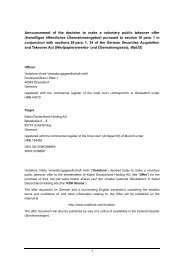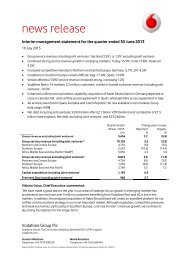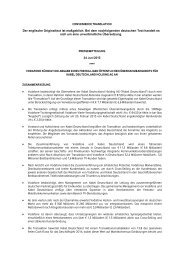You also want an ePaper? Increase the reach of your titles
YUMPU automatically turns print PDFs into web optimized ePapers that Google loves.
20<br />
On-net Pricing in Mobile Moving the debate forward • The Policy Paper Series • Number 8 • April 2008<br />
Introducing network asymmetry, I find that it is the smaller,<br />
rather than the larger network that is affected more by the<br />
endogenous penetration rate. Figure 16 shows, with the same<br />
exaggerated subscription elasticity of -2.5, that the larger<br />
network would still prefer bill and keep, while the smaller<br />
network would strictly prefer a positive (although below-cost)<br />
reciprocal access charge.<br />
Figure 16: The effect of endogenous participation and<br />
asymmetry on profit-maximising reciprocal access charge<br />
Profit (100% = access at cost)<br />
105%<br />
100%<br />
95%<br />
90%<br />
Large Small<br />
85%<br />
20% 30% 40% 50% 60% 70% 80% 90% 100% 110% 120% 130% 140%<br />
Access Charge as % of Cost<br />
Source: Frontier model<br />
I stated previously that because TMNEs intensify competition,<br />
setting above-cost access charges can increase consumer<br />
surplus. My modelling shows that the introduction of an<br />
endogenous penetration rate intensifies competition even<br />
further. As a consequence the result that consumer surplus<br />
can be increased by setting access charges above cost is even<br />
stronger in the presence of an endogenous penetration rate.<br />
This is illustrated in Figure 17 below.<br />
Figure 17: Impact of access charge on penetration<br />
Consumer surplus (100% = access at cost)<br />
105%<br />
104%<br />
103%<br />
102%<br />
101%<br />
100%<br />
99%<br />
98%<br />
97%<br />
96%<br />
Fixed penetration Endog. penetration<br />
95%<br />
60% 70% 80% 90% 100% 110% 120% 130% 140%<br />
Access Charge as % of Cost<br />
Source: Frontier model<br />
Comments on network externalities<br />
In the presence of network externalities Schiff shows that<br />
the networks will profit maximise by pricing access below<br />
marginal cost (even though they are charging uniform on-net and<br />
off-net prices), while consumer surplus is maximised by pricing<br />
access above marginal cost. The intuition of this result is that<br />
externalities make competition even fiercer in a non-linear<br />
way. Adding a customer when access is priced above cost<br />
creates profits directly and increases the volume of calls by<br />
existing customers, which multiplies the profit. The networks<br />
would choose to mitigate competition by setting the price<br />
of access (and calls) below cost to offset the effect of the<br />
network externality. Total welfare on the other hand is<br />
maximised with access priced above marginal cost, because<br />
this leads to a lower rental charge, which in turn drives up<br />
the penetration rate. 33<br />
I have not replicated this modelling in the current analysis,<br />
because the modelling of externalities is extremely sensitive<br />
to the parameters used. However my intuition is that<br />
Schiff’s results are consistent with the preceding analysis.<br />
The introduction of externalities may somewhat strengthen<br />
the tendency of profit maximising operators to set access<br />
charges below cost, but also strengthens the welfare<br />
argument for above cost access charge.<br />
Comments on customer heterogeneity<br />
In each of the models presented above it can be shown that it<br />
is efficient for networks to price calls at (perceived) marginal<br />
cost and for them to compete over the level of the rental<br />
charge. However, this results from the fact that in each model<br />
subscribers are assumed all to have the same demand to<br />
make calls once they have joined a network.<br />
If the models are generalised further so that consumers<br />
vary in their characteristics, either in terms of the volume of<br />
calls they would make at a given call price, or in terms of the<br />
volume of calls they receive, then it no longer is the case that<br />
it will be efficient for networks to price calls at marginal cost.<br />
This is an aspect of pricing dealt with by Dessein and by<br />
Houpis & Valletti. 34 The specific insight that these papers bring<br />
is that they show that when the marginal subscriber makes<br />
fewer calls than the average caller then it will be efficient to<br />
price calls above marginal cost and reduce rentals.<br />
Both LRT (1998) and Armstrong (1998) argue (without formal<br />
proof) that once customers are heterogeneous in their<br />
consumption and access prices differ from marginal cost<br />
then the market outcome is likely to resemble the collusive<br />
outcome created by linear pricing, even if two-part tariffs are<br />
used in practice. Dessein demonstrates that this is not the<br />
case. He shows that LRT’s profit neutrality result holds even<br />
in the presence of customer heterogeneity. Moreover, he<br />
extends Schiff’s result by showing that in the presence of<br />
customer heterogeneity and externalities networks would<br />
choose to price access below marginal cost while welfare is<br />
maximised by pricing access above marginal cost. Houpis &<br />
Valletti note specifically that results are sensitive to the way in<br />
which heterogeneity is modelled. If the differences between<br />
subscribers are additive then marginal cost pricing will remain<br />
efficient, while other formulations tend to result in pricing<br />
calls above marginal cost.<br />
Schiff’s paper is a good example of this. An endogenous<br />
participation rate is explained by customers having an<br />
“option value” from subscription which is randomly<br />
distributed, but unrelated to the calls they make if they<br />
become subscribers because of the additive structure that<br />
Schiff has chosen. Hence in Schiff’s model, even in the<br />
presence of externalities, the marginal customer makes<br />
the same number of calls as the average customer so the<br />
conditions for marginal cost pricing still hold. By contrast,<br />
in Dessein’s model, customers are split into low and high<br />
calling (and receiving) behaviour. Inevitably marginal

















